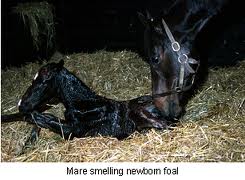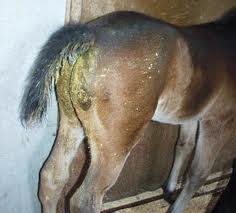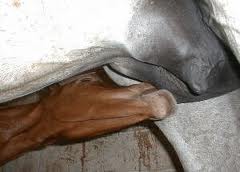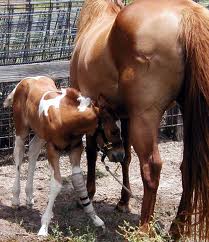|
The Birth of Your Foal !
Congratulations! The long-awated day is finally here and your foal has arrived. The first 24 hours after birth are extremely important for your foals healthy start. Your new born will usually stand within 30 minutes, typically after several failed attempts. As soon as it is steady on its feet, often within an hour of birth, the newborn will attempt to nurse. Teat-seeking behavior is persistent, even somewhat random, because the they do not know exactly where the teat is located. However, with the gentle assistance of the mare, he will find the teat, quickly understand its purpose, and know how to suckle, a behavior that is instinctive in horses.

If you are present during the birth, your first step after the delivery is to make sure the baby is breathing. Quietly approach the birthing area and remove the sack (amnion) from the newborns head. If the he is breathing, your job is complete and you should leave the birthing area and observe the mare and baby from a distance. This allows the the two time alone to recover from the delivery and bond to each other socially. A normal, healthy newborn lifts its head and neck and rolls onto its chest within several seconds after delivery. If the mare has not stood up yet, the baby's movements usually break the naval(umbilical) cord. You should wait for either the mare or foal to break the umbilical cord. Do not cut the umbilical cord immediately after birth, because it is thought the baby receives blood from the placenta after birth. Cutting the cord before this blood transfer may result in circulatory problems in the foal. New borns with circulatory problems typically seem dumb and may have convulsions, leading to the common terms of "dummy" or "wanderer" for this condition.
Once the umbilical cord breaks, the stump should be dipped in a mild, 1 to 2 percent iodine solution. The iodine drys the umbilical stump and prevents bacteria from traveling up the stump and entering the newborn's body. Bacteria that enter the baby through the umbilical stump cause a systemic infection known by various names, such as shigellosis, naval ill, joint ill, or polyarthritis. This infection causes severe illness or death in foals and causes swelling and deformities in the baby's joints. You should examine the naval stump for several days after birth to make sure that it remains dry. Urine dripping from the stump indicates that the fetal urine passage from the bladder to the umbilical (the urachus) has not closed. Normally the urachus closes at birth. If it fails to close, in a condition called "persistent urachus," the newborn should be treated by a veterinarian.
It is important for the baby to receive colostrum soon after birth because it contains antibodies needed for disease protection during the first few months of the newborn's life. These antibodies can be absorbed by the intestinal tract for up to 36 hours after birth, but absorptive ability begins decreasing drastically at 12 hours after birth. Therefore it is important he receives colostrum before this time has passed. Your veterinarian can perform a simple test to determine if the newborn has received adequate protection from colostrum. This test should be done about 6 hours after birth. To ensure that the mare has high amounts of antibodies in her colostrum, vaccinate her approximately 30 days before the birth. If you miss this vaccination time, make sure the newborn is protected against tetanus by giving it a tetanus antitoxin injection at birth. The tetanus antitoxin is less efficient than immunity from colostrum because it protects the baby for only 2 to 3 weeks while its umbilical stump heals. Because the baby's immune system is not mature enough to use a tetanus toxoid vaccination until it is 3 to 5 months old, the newborn is unprotected for 2-1/2 to 3 months if it does not receive protection from the colostrum.
Colostrum has a laxative effect on the baby, which helps it pass the fetal excrement (meconium), usually passed within 4 hours after birth. If the meconium is not passed, the baby can become constipated. A constipated newborn frequently stops moving, squats, and raises its tail trying to defecate. Constipation can be relieved easily by giving a warm, soapy water enema (1 to 2 cups) or a prepackaged human mineral oil enema. Diarrhea in the newborn is not common and may indicate a serious illness. A squirting type of diarrhea can result in dehydration and death in a few hours. Immediately consult your veterinarian if your newborn develops diarrhea. However, mild diarrhea is common in older foals (1 to 2 weeks of age). This diarrhea often occurs during the mare's foal heat (a fertile heat beginning approximately 7 to 9 days after foaling) and is commonly termed "scours."

In the past, horse breeders thought hormonal changes in the mare's milk during foal heat caused diarrhea in the baby. Recent research has implicated an internal parasite (Strongyloides westeri) as the true cause of foal heat scours. This parasite is transmitted from the dam to the baby through the mammary gland. Foals begin to shed eggs in their feces 10 to 14 days after birth, resulting in scours that coincidentally occur with foal heat in the mare. If the baby is alert and nursing regularly, mild scours usually do not harm it. However if the baby stops nursing and becomes weak or dehydrated, consult your veterinarian immediately. You should keep the scoured areas around the baby's buttocks clean to prevent scalding of the skin. Wash the area with mild soap and water and coat it with petroleum jelly to prevent scalding.
Some foals may be born with hernias (defects in the body wall that allow part of the intestines to protrude under the skin). Hernias occur most frequently at the naval and scrotal areas. Small hernias often correct themselves with time, and larger hernias may require surgical correction. Again, this is a situation that your veterinarian should assess and treat. Occasionally the newborn's eyelids and lashes are turned in toward the eye rather than turned out as normal. This is a condition called "entropion" and causes tearing and irritation of the eye. Consult your veterinarian for the proper eye ointment or treatment that you can perform.
Another infrequent problem in newborns is caused by an incompatibility between blood groups of the mare and baby. This condition is known as "neonatal isoerythrolysis" or "jaundice foal." Antibodies to the foal's red blood cells are formed by the mare and secreted in her colostrum. When the newborn nurses and absorbs these antibodies, its red blood cells are destroyed. Without prompt veterinary treatment, the newborn becomes anemic and dies. If you suspect neonatal isoerythrolysis, prevent the newborn from consuming colostrum until you can get a veterinarian to test for the condition.
Orphan foals can result from death of the mare, inability of the mare to produce milk, or maternal rejection. Orphan's can be raised successfully with some extra care. As with mothered newborns, you should make sure the orphan receives colostrum soon after birth. If that is not possible, try to locate frozen colostrum (large breeding farms and your veterinarian are good sources). Thaw the frozen colostrum at room temperature. Microwaving or heating the colostrum can destroy the protective antibodies in it. In the absence of any colostrum, your veterinarian can give the newborn a plasma transfusion or an oral colostrum replacer to get antibodies into its system. The best and easiest solution for an orphan is to transfer it to a nurse mare. The nurse mare usually must be restrained or tranquilized for several days until she willingly lets the orphan nurse. Another solution is to bottle-feed or bucket-feed the foal with a mare's milk replacer.
The last stage of foaling is the passing of the afterbirth. If there has been a normal birth, mares will stand some 15 to 20 minutes after giving birth and begin to nuzzle and lick the foal. The afterbirth is usually expelled within one to two hours after birth.
Return from Foal to Horse Riding Connection
|
 Usually, newborns stand within 1 hour after birth. During the first standing attempts, the baby is unsteady and constantly shifting its head, neck, and feet in an attempt to remain balanced. This unsteadiness is normal, and you should let the him stand by himself. Lifting the newborn onto its feet before its legs are strong enough to support it may strain tendons and ligaments, and it interferes with the bonding process between the mare and foal. The baby should begin nursing attempts right away, instinctively searching at the junction of the mare's legs (both front and back) and body for the udder. The exploratory process involved with finding the udder is normal, and, again, you should resist the desire to "help". Human interference during initial nursing attempts actually may slow the baby's progress in finding the udder, and it interferes with the mare-foal bond. However, if he has not nursed by 2 hours after birth or if the mare aggressively rejects the his attempts to nurse, then it is time to interfere. Help the baby stand up and gently guide it to the mare's udder.
Usually, newborns stand within 1 hour after birth. During the first standing attempts, the baby is unsteady and constantly shifting its head, neck, and feet in an attempt to remain balanced. This unsteadiness is normal, and you should let the him stand by himself. Lifting the newborn onto its feet before its legs are strong enough to support it may strain tendons and ligaments, and it interferes with the bonding process between the mare and foal. The baby should begin nursing attempts right away, instinctively searching at the junction of the mare's legs (both front and back) and body for the udder. The exploratory process involved with finding the udder is normal, and, again, you should resist the desire to "help". Human interference during initial nursing attempts actually may slow the baby's progress in finding the udder, and it interferes with the mare-foal bond. However, if he has not nursed by 2 hours after birth or if the mare aggressively rejects the his attempts to nurse, then it is time to interfere. Help the baby stand up and gently guide it to the mare's udder. 
